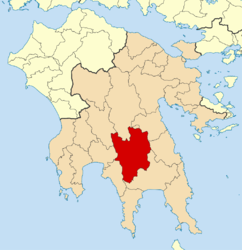Sparta (modern)
|
Sparta Σπάρτη |
|
|---|---|

The centre of the city
|
|
| Coordinates: 37°4′N 22°26′E / 37.067°N 22.433°ECoordinates: 37°4′N 22°26′E / 37.067°N 22.433°E | |
| Country | Greece |
| Administrative region | Peloponnese |
| Regional unit | Laconia |
| Government | |
| • Mayor | Stavros Argeitakos (as of 2012[update]) |
| Area | |
| • Municipality | 1,181.8 km2 (456.3 sq mi) |
| • Municipal unit | 84.5 km2 (32.6 sq mi) |
| Lowest elevation | 200 m (700 ft) |
| Population (2011) | |
| • Municipality | 35,259 |
| • Municipality density | 30/km2 (77/sq mi) |
| • Municipal unit | 19,854 |
| • Municipal unit density | 230/km2 (610/sq mi) |
| Community | |
| • Population | 17,408 (2011) |
| Time zone | EET (UTC+2) |
| • Summer (DST) | EEST (UTC+3) |
| Postal code | 231 00 |
| Area code(s) | 27310 |
| Vehicle registration | ΑΚ |
| Website | www |
Sparta (Greek: Σπάρτη, Spártī), is a city in Laconia, Greece. It lies at the site of ancient Sparta. The municipality population in 2011 was 35,259, of whom 17,408 lived in the city.
Until modern times, the site of ancient Sparta was occupied by a town of a few thousand people who lived among the ruins, in the shadow of Mystras, a more important medieval Greek settlement. The Palaiologos family (the last Byzantine Greek imperial dynasty) also lived in Mystras. In 1834, after the Greek War of Independence, King Otto of Greece decreed the town should be expanded into a city.
In the center of the city is the Archaeological Museum and in the North West end is the Tomb of Leonidas, also known as Leonidaion and there is a tavern in front of the temple named Leonidas. The city's cathedral is at the south west end. North of the modern city start the ruins of the ancient Sparta. Entering by the South Gate of the Acropolis, known as Lakedaemonia, there is the Rotunda, the Theatre and the Temple of Athena Chalkioikos to the West and to the North is the 10th Century AC Monastic Church of Osios Nikonas. Exiting the Acropolis by the North Gate there are the remains of the earliest ancient walls, the Heroon and the Altar of Lycourgos, whereas to the East there is the Sanctuary of Artemis Orthia.
The Museum of the Olive and Greek Olive Oil in the South West end highlights the culture of the olive and the technology of olive production.
Modern day Sparta, capital of the prefecture of Lakonia, lies on the eastern foothills of Mount Taygetos in the Evrotas River valley. The city has been built upon the site of ancient Sparta. To the southwest stands Mt. Taygetos. To the east of the city stands the Parnonas mountain range, which is forested predominantly with Greek fir trees and other pines.
Modern Sparta's origins date back to October 20, 1834, when King Otto issued a decree on the construction of the new city. Bavarian city planners, headed by Fr. Stauffert, designed a city of 100,000 inhabitants based on the neo-classical architectural model.
...
Wikipedia


